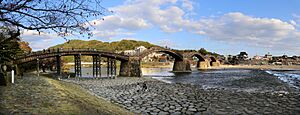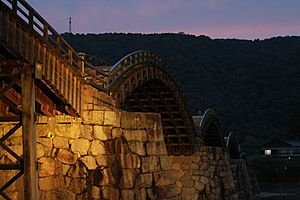Kintai Bridge facts for kids
The Kintai Bridge (pronounced Kin-tie) is a super cool and old wooden bridge in Iwakuni, a city in Yamaguchi Prefecture, Japan. It's famous for its five amazing arches!
This special bridge was built way back in 1673. It stretches across the Nishiki River and is made entirely of wood. You can find it right at the bottom of a mountain called Mt. Yokoyama, where the old Iwakuni Castle sits at the top.
The area around the bridge, called Kikkou Park, is a really popular place for tourists to visit. It's especially beautiful in the spring when the cherry blossoms bloom, and in the autumn when the Japanese maple trees turn bright red and orange. Because it's so important and beautiful, the Kintai Bridge was named a National Treasure in 1922.
Contents
A Bridge Through Time

Before the Kintai Bridge, other wooden bridges were built in this spot. But the Nishiki River often flooded, washing them away!
The third lord of the area, Kikkawa Hiroyoshi, decided to build a stronger bridge in 1673. He used strong stone supports instead of wood. But even this new bridge was washed away by a flood the very next year!
So, the stone supports were made even stronger. People also started paying a special tax to help keep the bridge in good shape. This money was used to rebuild parts of the bridge regularly:
- Every 20 years, the three middle sections were rebuilt.
- Every 40 years, the two sections connecting to the river banks were rebuilt.
This careful plan worked! The Kintai Bridge stood strong for 276 years. But then, in 1950, a huge typhoon called "Kijia" caused a massive flood. The bridge was weaker than usual because it hadn't been maintained during World War II. Sadly, it was washed away again.
Luckily, the bridge was rebuilt in 1953, looking just like the original. Between 2001 and 2004, all five parts of the bridge were carefully restored again, making sure it stays strong for many more years.
How the Bridge Was Built
The Kintai Bridge is made of five wooden arches. It rests on four strong stone supports in the river and two wooden supports on the dry riverbed at each end.
The three middle sections of the bridge are each about 35.1 meters (115 feet) long. The two end sections are a little shorter, about 34.8 meters (114 feet) long. All together, the bridge is about 175 meters (574 feet) long and 5 meters (16 feet) wide.
Building Without Nails
For almost 300 years, the Kintai Bridge was built without using any metal nails! How did they do it? The wooden pieces were cut and fitted together perfectly, like a giant puzzle. Thick wooden beams were clamped and tied together with strong metal straps. To make the bridge last even longer, the main wooden parts were covered with sheets of copper.
Smart Flood Protection
The bridge was designed to be super strong from the top. But what about floods? The builders were very clever. The wooden pathway of the bridge was designed to "float" on top of its frame. It used special mortise and tenon joints, which are like pegs and holes.
This smart design meant that if the river flooded badly, the rising water could lift the wooden pathway off its frame and carry it downstream. This saved the main structure of the bridge from being completely destroyed. Then, after the flood, the pathway could be rebuilt more easily.
See also
 In Spanish: Puente Kintai para niños
In Spanish: Puente Kintai para niños




